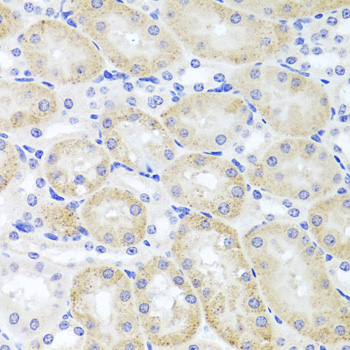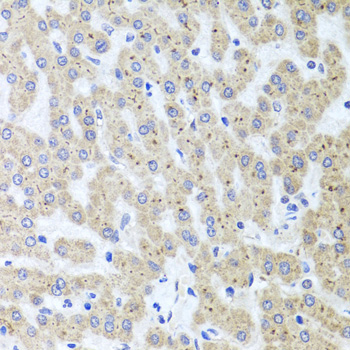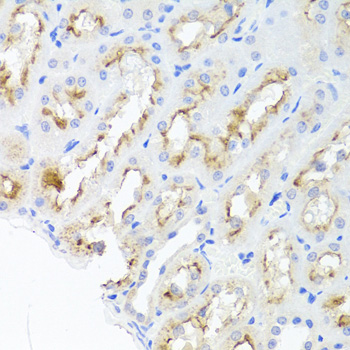Anti-ADIPOQ Antibody (CAB2543)
- SKU:
- CAB2543
- Product type:
- Antibody
- Reactivity:
- Human
- Mouse
- Rat
- Host Species:
- Rabbit
- Isotype:
- IgG
- Research Area:
- Cell Biology
Description
| Antibody Name: | Anti-ADIPOQ Antibody |
| Antibody SKU: | CAB2543 |
| Antibody Size: | 20uL, 50uL, 100uL |
| Application: | WB IHC IF |
| Reactivity: | Human, Mouse, Rat |
| Host Species: | Rabbit |
| Immunogen: | Recombinant fusion protein containing a sequence corresponding to amino acids 19-104 of human ADIPOQ (NP_004788.1). |
| Application: | WB IHC IF |
| Recommended Dilution: | WB 1:500 - 1:2000 IHC 1:50 - 1:100 IF 1:50 - 1:100 |
| Reactivity: | Human, Mouse, Rat |
| Positive Samples: | Mouse kidney |
| Immunogen: | Recombinant fusion protein containing a sequence corresponding to amino acids 19-104 of human ADIPOQ (NP_004788.1). |
| Purification Method: | Affinity purification |
| Storage Buffer: | Store at -20°C. Avoid freeze / thaw cycles. Buffer: PBS with 0.02% sodium azide, 50% glycerol, pH7.3. |
| Isotype: | IgG |
| Sequence: | ETTT QGPG VLLP LPKG ACTG WMAG IPGH PGHN GAPG RDGR DGTP GEKG EKGD PGLI GPKG DIGE TGVP GAEG PRGF PGIQ GRKG EP |
| Gene ID: | 9370 |
| Uniprot: | Q15848 |
| Cellular Location: | Secreted |
| Calculated MW: | 26kDa |
| Observed MW: | 30kDa |
| Synonyms: | ADIPOQ, ACDC, ACRP30, ADIPQTL1, ADPN, APM-1, APM1, GBP28 |
| Background: | This gene is expressed in adipose tissue exclusively. It encodes a protein with similarity to collagens X and VIII and complement factor C1q. The encoded protein circulates in the plasma and is involved with metabolic and hormonal processes. Mutations in this gene are associated with adiponectin deficiency. Multiple alternatively spliced variants, encoding the same protein, have been identified. |
| UniProt Protein Function: | adiponectin: Important adipokine involved in the control of fat metabolism and insulin sensitivity, with direct anti-diabetic, anti-atherogenic and anti-inflammatory activities. Stimulates AMPK phosphorylation and activation in the liver and the skeletal muscle, enhancing glucose utilization and fatty-acid combustion. Antagonizes TNF-alpha by negatively regulating its expression in various tissues such as liver and macrophages, and also by counteracting its effects. Inhibits endothelial NF-kappa-B signaling through a cAMP-dependent pathway. May play a role in cell growth, angiogenesis and tissue remodeling by binding and sequestering various growth factors with distinct binding affinities, depending on the type of complex, LMW, MMW or HMW. Homomultimer. Forms trimers, hexamers and 12- to 18-mers. The trimers (low molecular weight complexes / LMW) are assembled via non-covalent interactions of the collagen-like domains in a triple helix and hydrophobic interactions within the globular C1q domain. Several trimers can associate to form disulfide-linked hexamers (middle molecular weight complexes / MMW) and larger complexes (higher molecular weight / HMW). The HMW-complex assembly may rely aditionally on lysine hydroxylation and glycosylation. LMW, MMW and HMW complexes bind to HBEGF, MMW and HMW complexes bind to PDGFB, and HMW complex binds to FGF2. Interacts with CTRP9A via the C1q domain (heterotrimeric complex). Synthesized exclusively by adipocytes and secreted into plasma. |
| UniProt Protein Details: | Protein type:Secreted, signal peptide; Endoplasmic reticulum; Secreted; Hormone Chromosomal Location of Human Ortholog: 3q27 Cellular Component: extracellular space; collagen; cell surface; endoplasmic reticulum; extracellular region Molecular Function:identical protein binding; protein binding; protein homodimerization activity; hormone activity; cytokine activity; sialic acid binding; receptor binding Biological Process: circadian rhythm; negative regulation of phagocytosis; negative regulation of MAP kinase activity; negative regulation of smooth muscle cell proliferation; negative regulation of hormone secretion; positive regulation of cellular protein metabolic process; response to glucocorticoid stimulus; membrane hyperpolarization; negative regulation of smooth muscle cell migration; glucose homeostasis; negative regulation of granulocyte differentiation; positive regulation of interleukin-8 production; positive regulation of glucose import; negative regulation of gluconeogenesis; response to glucose stimulus; adiponectin-mediated signaling pathway; negative regulation of protein amino acid autophosphorylation; negative regulation of blood pressure; negative regulation of cell migration; protein homooligomerization; response to nutrient; generation of precursor metabolites and energy; positive regulation of I-kappaB kinase/NF-kappaB cascade; positive regulation of signal transduction; negative regulation of heterotypic cell-cell adhesion; glucose metabolic process; negative regulation of tumor necrosis factor production; negative regulation of I-kappaB kinase/NF-kappaB cascade; negative regulation of fat cell differentiation; negative regulation of synaptic transmission; response to sucrose stimulus; membrane depolarization; positive regulation of peptidyl-tyrosine phosphorylation; response to ethanol; fatty acid beta-oxidation; positive regulation of fatty acid metabolic process; cellular response to insulin stimulus; negative regulation of macrophage differentiation; negative regulation of low-density lipoprotein receptor biosynthetic process; negative regulation of inflammatory response; brown fat cell differentiation; response to hypoxia; fatty acid oxidation; positive regulation of protein amino acid phosphorylation; response to activity; negative regulation of transcription, DNA-dependent; positive regulation of myeloid cell apoptosis; positive regulation of blood pressure Disease: Adiponectin, Serum Level Of, Quantitative Trait Locus 1 |
| NCBI Summary: | This gene is expressed in adipose tissue exclusively. It encodes a protein with similarity to collagens X and VIII and complement factor C1q. The encoded protein circulates in the plasma and is involved with metabolic and hormonal processes. Mutations in this gene are associated with adiponectin deficiency. Multiple alternatively spliced variants, encoding the same protein, have been identified. [provided by RefSeq, Apr 2010] |
| UniProt Code: | Q15848 |
| NCBI GenInfo Identifier: | 2493789 |
| NCBI Gene ID: | 9370 |
| NCBI Accession: | Q15848.1 |
| UniProt Secondary Accession: | Q15848,Q58EX9, |
| UniProt Related Accession: | Q15848 |
| Molecular Weight: | 25.1 kDa (231 aa) |
| NCBI Full Name: | Adiponectin |
| NCBI Synonym Full Names: | adiponectin, C1Q and collagen domain containing |
| NCBI Official Symbol: | ADIPOQ |
| NCBI Official Synonym Symbols: | ACDC; ADPN; APM1; APM-1; GBP28; ACRP30; ADIPQTL1 |
| NCBI Protein Information: | adiponectin |
| UniProt Protein Name: | Adiponectin |
| UniProt Synonym Protein Names: | 30 kDa adipocyte complement-related protein; Adipocyte complement-related 30 kDa protein; ACRP30; Adipocyte, C1q and collagen domain-containing protein; Adipose most abundant gene transcript 1 protein; apM-1; Gelatin-binding protein |
| Protein Family: | Adiponectin |
| UniProt Gene Name: | ADIPOQ |
| UniProt Entry Name: | ADIPO_HUMAN |







